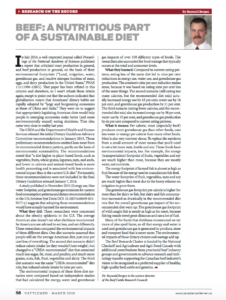Beef: a Nutritious Part of a Sustainable Diet
This article written by Dr. Reynold Bergen, BCRC Science Director, originally appeared in the March 2016 issue of Canadian Cattlemen magazine and is reprinted on the BCRC Blog with permission of the publisher.
In July 2014, a well-respected journal called Proceedings of the National Academy of Sciences published a report that criticized meat production in general, and beef production in general, on the basis of their environmental footprints (“Land, irrigation, water, greenhouse gas, and reactive nitrogen burdens of meat, eggs, and dairy production in the United States”, PNAS 111:11996-12001). That paper has been refuted in this column and elsewhere, so I won’t rehash those details again, except to point out that the authors indicated that globalization meant that Americans’ dietary habits are rapidly adopted by “large and burgeoning economies as those of China and India”. They went on to suggest that appropriately legislating American diets would help people in emerging economies make better (and more environmentally sound) eating decisions. That idea came very close to reality last year.
The USDA and the Department of Health and Human Services released the initial Dietary Guidelines Advisory Committee recommendations in January 2015. Those preliminary recommendations omitted lean meat from its recommended dietary pattern, partly on the basis of environmental sustainability. The recommendations stated that “a diet higher in plant-based foods, such as vegetables, fruits, whole grains, legumes, nuts, and seeds, and lower in calories and animal-based foods is more health promoting and is associated with less environmental impact than is the current U.S. diet”. Fortunately, those recommendations were not included in the final Dietary Guidelines released January 7, 2016.
A study published in November 2015 (Energy use, blue water footprint, and greenhouse gas emissions for current food consumption patterns and dietary recommendations in the US; Environ Syst Decis DOI 10.1007/s10669-015-9577-y) suggests that adopting those recommendations would have actually harmed the environment.
What they did
These researchers were concerned about the obesity epidemic in the US. The average American also doesn’t eat what dieticians recommend. So Americans are advised to eat less, and eat differently. These researchers compared the environmental impacts of three different diets. One diet scenario assumed that people still ate the average American diet, just 9% less of everything. The second diet scenario didn’t reduce caloric intake (so they wouldn’t lose weight), but changed to a “USDA recommended” diet that contained much less sugar, fat, meat, and poultry, and much more grains, nuts, fish, fruit, vegetables and dairy. The third diet scenario was the same “USDA recommended” diet mix, but reduced caloric intake by 9%. The environmental impacts of these three diet scenarios were compared based on independent studies that had calculated the energy, water and greenhouse gas impacts of over 100 different types of foods. The researchers also accounted for food wastage that typically occurs at the retail and consumer levels.
What they learned
Compared to current eating patterns, eating less of the same diet led to 9% reductions in energy use, water use, and greenhouse gas production. The consistent 9% reduction makes sense, because it was based on eating 9% less of the same things. The second scenario (still eating too many calories, but the recommended diet mix) actually increased energy use by 43%, water use by 16%, and greenhouse gas production by 11%. The third scenario (eating fewer calories, and the recommended diet mix) also increased energy use by 38%, water use by 10%, and greenhouse gas production by 6% compared to current eating patterns.
What it means
Per calorie, meat (especially beef) produces more greenhouse gas than other foods, uses less water or energy per calorie than many other foods. Meat is also very nutrient-dense. To replace the nutrients from a small amount of meat means that you’d need to eat a lot more nuts, lentils and soy. Those foods have environmental impacts, too. For example, the energy (transportation) footprint of fruits, vegetables and soy are much higher than meat, because they are mostly water, not nutrients. The energy footprint of farmed fish is almost as high as fruit because of the energy used to manufacture fish feed. The water footprint of fruit, vegetables, nuts and soy are much higher than meat due to the heavy reliance on irrigation to grow them. The greenhouse gas footprint per calorie is higher for meat than for dairy or fish, but dairy and fish consumption increased so drastically in the recommended diet mix that the overall greenhouse gas impact of the recommended diet went up. The greenhouse gas footprint of wild caught fish is nearly as high as for meat, because fishing vessels travel great distances and use a lot of fuel. Many of the foods that dieticians recommend we eat more of also spoil faster, so all that energy and water is used and greenhouse gas is generated to produce, store and transport food that is never eaten. The environmental impacts of those dietary choices and wastage add up.
Related: Hot Air Doesn’t Just Come from Cattle
Click here to subscribe to the BCRC Blog and receive email notifications when new content is posted.
The sharing or reprinting of BCRC Blog articles is typically welcome and encouraged, however this article requires permission of the original publisher.
We welcome your questions, comments and suggestions. Contact us directly or generate public discussion by posting your thoughts below.
